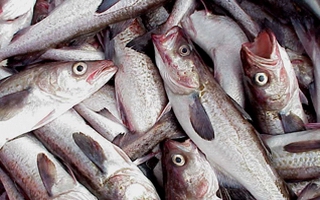 Chinese processors is driving capacity expansion at some of Russia’s largest ground fishing operations. Based in the far-eastern city of Vladivastock, Sigma Marine has doubled its capacity over the past year to 85,000 tons, having added vessels and quota from smaller competitors, explained Igorevna Ekaterina Prudnikova, head of export sales.
Chinese processors is driving capacity expansion at some of Russia’s largest ground fishing operations. Based in the far-eastern city of Vladivastock, Sigma Marine has doubled its capacity over the past year to 85,000 tons, having added vessels and quota from smaller competitors, explained Igorevna Ekaterina Prudnikova, head of export sales.“More people have gotten into fishing because the prices are higher now and will continue to rise,” according to Prudnikova. She said that better environmental regulations (including recent MSC certification) has added value to pollock, which accounts for half of Russia’s seafood exports in value and volume terms.
Prudnikova reported how the firm’s 13 vessels focus on the Okhotsk and Bering seas for Alaska Pollock, herring, Pacific cod as well as halibut and crabs. A client base of Chinese processing factories are expected to buy 53,000 tons of Alaska pollock this year, a radical increase on the firm’s 22,687 tons sold in Chona in 2011. Meanwhile, quantities of Pacific cod will grow from 4,985 tons to 8500 tons while Pacific herring shipments are set to go from 3,800 in 2011 to 19,000 this year.
The Sea of Okhotsk is a sheltered part of the northwest Pacific Ocean, spreading from Sakhalin islandin the west to the Kamchatka peninsula in the east near where Russia meets Japan. That makes its herring and Pollock catches easy to ship to main Chinese and Japanese markets. Sales of halibut tails and heads are solid in China while cod stomach and roe is in demand in China and Japan, said Prudnikova.
Sigma Marine supplies Chinese customers through transhipment to larger vessels that then continue to Dalian and Qingdao (Russian law requires that all fish caught in Russian waters are first recorded in a Russian port). “January to April is the high season, we expect prices will be high,” said Prudnikova. The other season runs from October to December.
Chinese fishery industry watchers see China as best-positioned in the long-term for Russian supply. A round up of cod prices published by CAPPMA stressed that China was better placed than other markets for stocks from Russian far-east waters such as the Sea of Okhotsk due to more efficient and affordable logistics.
China’s seafood sector often appears under-informed about pollock pricing: China Aquatic Products Processing and Marketing Association (CAPPMA) collates data published by EU and U.S. industry bodies.
Even though the Bering Sea volume has shrunk prices have not risen, pointed out the Chinese report, which credited weak demand in Spain and Latin America for the trend. “We can expect prices for cod and pollock to weaken in 2013,” according to a recent CAPPMA document distributed to members.
Sigma fishes only in “ecological fishing grounds,” said Prudnikova. The Sea of Okhotsk walleye pollock fishery has received Marine Stewardship Council (MSC) certification this year after being entered into assessment by the Pollock Catchers Association (PCA), an association of 45 fishing organizations accounting for more than 70 percent of the total quota share for pollock in the Russian Far East. The Russian Pollock Sustainability Alliance, a global group of companies, including Iglo Foods Group and Highliner Foods, collaborated with the Pollock Catchers Association to support the assessment.
While the Federal Fishery Agency (FFA) is tasked with managing national stocks, a thriving illegal trade has undermined prices and confidence in the Russian fishery trade, according to industry experts and environmentalists in Russia. Excessive Russian bureaucracy and flagrant poaching and illegal exports have all been blamed for the failure to expand a domestic pollock processing industry.
The PCA has estimated that illegal Pollock shipments equal Russia’s official exports. As part of the MSC certification requirements the PCA is expected to work with Russian fishery managers and international experts to improve the consistency and accuracy of the records of landings, meaning more reliable information into the future.
Figures vary but PCA data shows Russia’s 2012 pollock catch expanded 2.8 percent to 1.6 million tons — the Bering Sea was up 17 percent while the Sea of Okhotsk catch fell 7 percent. The Russian catch has been predicted at 1.7 million tons in 2013 Russian seafood exports in 2012 fell to USD 2.4 billion (EUR 1.8 billion, down 10 percent, with South Korea the top destination on USD 995 million (EUR 724 million) followed by China on USD 831.4 million (EUR 604.6 million) (35 percent of the total), and Japan, which accounted for USD 241.5 million (EUR 175.6 million) or 10 percent.
The fast-growing Alaska pollock fish ranks as the most-used ingredient for surimi — a product popular in the U.S. but also increasingly so in China with the rise of modern retailing and convenience food offerings. The fast-expanding 7-11 chain offers surimi in both cold and warm take-away meal options in Beijing stores.
While Russian investors have been attracted to fishing there’s also a lot of interest from China-focused outsiders. Headquartered in Hong Kong, the Scandinavian-controlled Ocean Trawlers Co operates a super freezer trawler, the Vladimir Starzhinsky, with a 2,600-ton hold, on the sea of Okhotsk.





